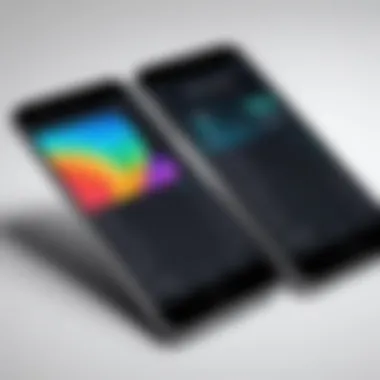Current Top Smartphones: An In-Depth Exploration


Intro
In today's fast-paced technological world, the smartphone has become not just a communication tool, but an extension of our very lives. With options flooding the market, discerning tech enthusiasts and everyday users alike might feel overwhelmed. How do you choose the best smartphone for your needs? This article aims to guide you through the maze of current top contenders, examining each for their features, specs, and overall value. Whether you're after a high-performance device for gaming, a camera marvel for photography, or a budget-friendly option that doesn't skimp on quality, this exploration has got you covered.
Product Overview
Understanding the landscape of today’s smartphones is crucial. The sheer variability in price, performance, and features makes it imperative to assess what exactly you are looking for. Each manufacturer boasts head-turning capabilities, from lightning-fast processors to breathtaking display technologies. As we examine specific models, we'll focus on key specifications that matter most, such as battery life, camera quality, and processing speed.
For instance, Apple's iPhone 15 introduces a series of powerful upgrades like the A17 bionic chip alongside improved camera features. Meanwhile, Samsung's Galaxy S23 Ultra showcases a 200-megapixel camera, aiming to redefine mobile photography.
Key Features and Specifications:
- Apple iPhone 15: 6.1-inch Super Retina XDR display, A17 chip, 48 MP main camera, supports 5G.
- Samsung Galaxy S23 Ultra: 6.8-inch Dynamic AMOLED, Snapdragon 8 Gen 2, up to 200 MP camera, 5,000 mAh battery.
- Google Pixel 8 Pro: 6.7-inch LTPO OLED, Tensor G3 chip, exceptional AI features in camera software.
Performance and User Experience
Performance is the beating heart of any smartphone. What good is a flashy design if your device is sluggish? Hands-on testing often reveals the practical implications of advertised specs. Take the OnePlus 11, for example—its Snapdragon 8 Gen 2 chip combined with 16 GB RAM delivers a buttery smooth experience. Multi-tasking? No sweat.
User interface plays a crucial role as well. Apple’s iOS provides a clean and straightforward experience, while Android—especially with brands like Samsung—allows for significant customization. Navigating through applications and settings feels natural, making users feel right at home.
When stacking these products side by side, it’s clear that while all offer stellar performance, personal preference can tip the scale.
Design and Build Quality
The aesthetic appeal and build quality are essential considerations when investing in a device. The Xiaomi 13 Pro stands out with its sleek glass back, offering a premium feel. In contrast, the Moto Edge+ favors a sturdy plastic shell that withstands drops better, although it may not have the same allure.
Materials matter. Devices like the Oppo Find X5 Pro, with its ceramic finish, not only elevate the look but also increase durability. Alongside ergonomics, aspects like weight and thickness can affect daily use; thicker devices may impede comfort during prolonged use.
Technology and Innovation
Groundbreaking technology shapes the trajectory of the smartphone industry. For instance, the transition to 5G connectivity has opened new avenues for app developers and users alike, promising lower latency and faster downloads. The Samsung Galaxy Z Fold 5 introduces flexible screens, pushing boundaries further—offering the possibility of a true multitasking device.
Moreover, AI-enhanced features are making waves. Smartphones like the Google Pixel 8 leverage machine learning to optimize camera results, making it feel as though you have a professional photographer in your pocket.
Pricing and Value Proposition
Understanding the financial aspect is equally as vital. High-end models often command prices beyond a thousand dollars; however, the value must justify the cost. Take the iPhone 15 Pro Max as an example; the price tag can raise eyebrows, but people frequently point to the ecosystem and performance as a worthy return.
On the other hand, the OnePlus Nord 2 positions itself nicely in the mid-range sector, offering impressive specs devoid of the flagship price. Comparison shopping can save consumers a chunk of change, as many solid options exist in every category.
The crux lies in identifying what features are worth the splurge based on individual needs.
"The right smartphone isn't necessarily the most expensive one; it’s the one that fits perfectly with your lifestyle."
Understanding the Criteria for the Best Phone
Understanding what makes a phone the best choice involves more than mere specifications. In a world where smartphones become almost an extension of ourselves, knowing what to look for is crucial. This section aims to dissect the elements that contribute to selecting the finest device for individual needs, ensuring you make a smart investment for your lifestyle.
Performance and Specifications
Performance is often linked with raw specifications—think processor speed, RAM, and storage capacity. These technical details can greatly influence how smoothly a device runs, especially with high-demand applications. Take, for example, the Apple A15 chip that powers the latest models. Its exceptional speed and efficiency can handle multitasking with ease, giving users a seamless experience when switching between gaming and productivity apps. On the flip side, Android devices with high-end Snapdragon or Exynos chips also offer impressive performance that can rival Apple.
Camera Quality


In the age of social media, camera quality can make or break a smartphone purchase. Many manufacturers focus heavily on camera specs, pushing the envelope with multi-lens setups and advanced sensors. For instance, the Samsung Galaxy S21 boasts a triple-lens system that captures intricate details even in low light, while the Google Pixel series is known for its exceptional image processing capabilities. Comparing features such as aperture size, optical zoom, and image stabilization can often lead to surprises representing a significant variance in photo quality.
Battery Life and Efficiency
No one wants to be caught with a dead phone when they need it the most. Battery life affects how well you can use your phone throughout the day without constantly reaching for a charger. Devices like the OnePlus 9 often provide long-lasting battery life due to optimizations and large capacities. Furthermore, fast-charging technology has turned a crucial corner, allowing users to recharge in a pinch without sacrificing longevity. Remember, a device's efficiency—how it uses battery power—is just as pertinent as capacity.
Design and Ergonomics
The aesthetic appeal and usability of a smartphone play a substantial role in the user's overall satisfaction. It's not just a piece of tech; it’s something we handle, hold, and view daily. Picking up a device with a sturdy design made from high-quality materials like glass or aluminum gives a sense of reliability. Comfort is also significant. A phone that sits nicely in the hand, whether it’s a compact size like the iPhone 13 mini, or something a bit larger, contributes to a better user experience that’s hard to understate.
Software and User Experience
When diving into smartphone choices, one cannot overlook the operating system. iOS and Android each have fluidities and unique features that cater to different user preferences. Apple's ecosystem provides a polished experience and seamless integrations between devices, while Android offers customization options that can cater to more tech-savvy users. The responsiveness of the user interface and the availability of software updates also play a vital role in enjoying a device to its fullest potential.
Price Considerations
It’s not just about bleeding-edge features; the price must resonate with the given value. Many premium models like the Samsung Galaxy S21 and iPhone 13 bring high entry costs but can justify it through their specifications and longevity. However, alternatives like the Google Pixel 5 or devices from Xiaomi have proven that substantial quality and performance don’t always have to come with a hefty bill. Weighing the cost against what you truly need can prevent overspending while still achieving satisfaction.
Selecting the best smartphone is about balancing performance, design, user experience, and budget, ensuring you find a device that truly fits your lifestyle.
Leading Smartphones in the Market
In today’s fast-paced world, choosing a smartphone is no small feat. The market is flooded with options, each promising a slew of features and enhancements. The importance of understanding what’s on offer cannot be overstated. Leading smartphones are not just devices; they are extensions of our daily lives, helping us to connect, work, and entertain ourselves. The best smartphones combine performance, user experience, and value for money in a way that resonates with both tech enthusiasts and everyday users alike.
Here, we break down the leading smartphones into three distinct categories, considering aspects like technology sophistication, unique offerings, and pricing strategy. This helps to illuminate the landscape for potential buyers, ensuring that when you fork over your hard-earned cash, it's for a device that aligns with your lifestyle and needs.
Top Flagship Devices
Flagship devices typically represent the pinnacle of what a manufacturer can achieve in terms of technology and design. These smartphones often come equipped with the latest hardware, cutting-edge features, and impeccable build quality. For instance, the Apple iPhone 14 Pro and Samsung Galaxy S23 Ultra have become emblematic of what flagship smartphones stand for.
- Performance: Both these models house high-end processors which ensure smooth multitasking and gaming without a hitch.
- Display Quality: With vibrant colors and sharp resolution, the displays not only enhance user experience but also make media consumption a delight.
- Camera Capabilities: The camera systems in flagship models are often unparalleled, allowing users to capture stunning images that can rival professional photography.
Choosing a flagship phone often means investing more, but the payoff in quality and performance is usually evident.
Mid-Range Phones Worth Noting
Not everyone requires the latest and greatest—or can afford it for that matter. Mid-range phones strike a balance between functionality and cost. Devices like the Google Pixel 7a and OnePlus Nord 2 are excellent choices for those who want solid performance without breaking the bank.
- Specifications: These phones often have very capable processors and good RAM, providing a satisfying level of performance for most tasks.
- User Experience: They typically run on versions of Android that are close to stock, ensuring smooth operation and quick updates.
- Camera Quality: While not quite flagship level, mid-range phones still deliver impressive camera capabilities, often excelling in software-enhanced photography.
Investing in a mid-range phone means you get more bang for your buck, with enough features to satisfy most users without unnecessary frills.
Budget-Friendly Options
For students, families, or anyone on a stringent budget, budget-friendly phones like Xiaomi Redmi Note 11 and Motorola Moto G Stylus offer incredible value. These devices often have surprisingly decent specs for their price.
- Affordability: The price point is lower, making them accessible for a wider audience.
- Essential Features: They generally cover all the basic needs—good enough display, adequate camera quality, and reliable battery life.
- Longevity: Certain budget models are built with durability in mind, ensuring they can stand up to daily wear and tear.
While these phones might lack high-end specifications, they offer essential connectivity and apps that can satisfy everyday tasks.
In summary, whether you are after flagship level, mid-range sturdiness, or budget-friendliness, the market has something that can cater to your specific needs. Choosing a smartphone is more than just a purchase; it can be a tool that enhances your daily life.
Detailed Comparisons of Selected Models
Understanding how different smartphones stack up against each other is crucial for any consumer looking to make an informed purchase. This section will dive deep into comparisons of select models, offering insights that can guide choices based on specific needs. By examining various categories—from flagship to budget-friendly models—potential buyers can weigh their options effectively and find a device that aligns with their lifestyle.


High-End Phone Comparison
When it comes to flagship smartphones, the competition is fierce. Models like the Apple iPhone 15 Pro and the Samsung Galaxy S23 Ultra continuously redefine what users expect from high-end devices. Here, we will explore key attributes such as:
- Performance: The latest Snapdragon or A-series chips can be a game changer. Speed and multitasking capabilities can easily sway users.
- Display Technology: Comparing AMOLED vs. OLED panels can surface differences that enhance viewing experiences.
- Camera Systems: This is often the differentiator. How do these powerhouse devices handle different lighting situations? What about zoom capabilities or software enhancements?
Each of these factors plays a pivotal role in determining a smartphone's overall value for money. Customers shouldn’t just focus on the price tag but also consider what features are bundled.
"Choosing a flagship phone isn’t only about specs; it's about personal usage patterns and expectations."
Mid-Tier Model Face-Off
When one ventures into mid-tier options, various brands, such as Google Pixel 7a and OnePlus Nord 3, offer excellent alternatives without emptying the wallet. Looking closely at:
- Build Quality: While premium devices have rich materials, mid-range models often surprise with sturdy designs that don’t scream "budget."
- Software Experience: OxygenOS or stock Android on these devices can be very refreshing, even compared to their more expensive siblings. How they handle updates is also crucial.
- Pricing vs. Performance: Surprisingly, some mid-range options rival flagships in everyday usage. This includes gaming, app usage, and general multitasking.
For many users, the mid-range market provides the sweet spot where quality meets price.
Budget Picks Showdown
Concluding this section is a look at budget smartphones, where models like the Motorola Moto G Power and Samsung Galaxy A14 shine. It’s easy to overlook them in the fast-paced tech world, but they hold value for specific needs:
- Battery Life: Often, budget devices prioritize long-lasting batteries. This can be a decisive factor for consumers who don’t want to reach for their chargers often.
- Essential Features: While lacking some high-end flair, key capabilities like reasonable camera performance and solid interfaces make them practical.
- User Recommendations: Feedback shared on platforms like Reddit often uncovers real user experiences that highlight what these budget models excel or struggle at.
In summary, performing these comparisons facilitates a clearer view of the options available. Understanding differences in performance, usability, and value across categories allows savvy buyers to pinpoint a model that meets their daily demands.
Emerging Trends in Smartphone Technology
The realm of smartphones is constantly evolving, and today’s trends can shape how we interact with these devices in the very near future. Understanding emerging trends in smartphone technology is crucial for individuals who want to stay ahead of the curve. From innovative design choices to major advancements in connectivity, these trends not only influence what devices become popular but also enhance user experience significantly. Moreover, recognizing these developments can inform purchasing decisions, ensuring that users choose devices that truly meet their needs and align with their lifestyle.
Foldable Displays
Foldable displays have made headlines in recent years and are a true game changer for the industry. By offering two screens that seamlessly combine into one larger display when needed, these devices promise a versatile user experience. For example, the Samsung Galaxy Z Fold series exemplifies how foldable phones can serve as both a phone and a tablet, giving users the flexibility to multitask like never before.
However, it’s not just about size. Foldable displays come with their own set of challenges. Durability is often a concern; consumers worry about how well these screens will hold up over time. Nevertheless, manufacturers are investing in robust technologies to address these issues, such as better hinges and upgraded glass materials. When considering a foldable device, it’s important to weigh these pros and cons carefully to decide whether the trade-offs align with your needs.
Advancements in Camera Technology
In the realm of smartphones, the camera often serves as the centerpiece that draws users in. Recent advancements have shifted focus onto high-resolution sensors, improved low-light capabilities, and AI-driven functionality. The Apple iPhone 15, for instance, features advanced computational photography which enhances image quality dramatically even in challenging conditions.
Not only do these shots look great, but the integration of features like portrait mode and night mode allows everyday users to capture professional-looking photos. This democratization of photography means more people can express their creativity without needing an expensive camera setup. For tech enthusiasts and casual users alike, the camera capabilities can significantly influence their choice of device.
5G Connectivity and Its Impact
5G connectivity has been touted as the next big thing in telecommunications, and rightly so. This new standard promises ultra-fast download speeds, low latency, and improved connectivity which can transform how users interact with their smartphones. Streaming, gaming, and video conferencing are just a few of the activities that benefit from the swifter connections that 5G brings.
However, 5G is not just about speed; it's about creating a more interconnected ecosystem. Mobile applications will continue to become more sophisticated, opening the door for innovations such as augmented reality shopping experiences and seamless smart home integration. The Huawei Mate 40 Pro is a notable example of a device that fully exploits the potential of 5G.
"With emerging technology, we are not just updating devices; we are redefining what a smartphone can do."
In essence, understanding these emerging trends equips users and tech enthusiasts alike with the knowledge to make informed decisions about their next smartphone purchases and what features to prioritize. As these technologies develop, they will shape the future of mobile communication and user experience.
User Experience and Customer Insights


When it comes to selecting a smartphone, how a device performs in daily settings—what many call user experience—holds paramount importance. User experience goes beyond just how the phone looks or its specifications. It encompasses the overall satisfaction a user derives from their device. This section aims to dissect various components of user experience and insights from customers, giving prospective buyers a clearer picture of what they can expect.
Real-Life Performance Reviews
Real-life performance reviews shed light on how smartphones truly operate in everyday situations. Unlike tech specs that read like an advanced calculus exam, these reviews speak the language of actual users, translating raw data into relatable experiences. Many users share anecdotes on platforms like Reddit or comments section of tech blogs about how their devices handle multitasking, gaming, and photography in real-world contexts.
For instance, a user might highlight that the iPhone 14 Pro Max excels in handling demanding applications without breaking a sweat, while the Galaxy S23 Ultra captures stunning photos even in low-light conditions. These performance reviews not only provide tangible results but also reveal quirks that might not be apparent in professional tests. An interesting tidbit often noted is how certain smartphone models perform differently based on Android or iOS optimizations—something that can only be determined through everyday use.
Consumer Satisfaction Ratings
Consumer satisfaction ratings play a significant role in understanding a smartphone's place in the market. Various research firms conduct surveys that assess how happy users are with their devices based on multiple factors such as ease of use, software updates, and customer support. Android Authority and Consumer Reports are notable resources that offer in-depth insights into these ratings.
According to recent satisfaction surveys, brands like Apple and Samsung consistently rank high due to their robust ecosystems and user-friendly interfaces. This doesn't mean everyone is dancing in the streets about their phones, though. Some users express concerns, particularly around things like software glitches or battery drain issues, which showcases the complexity of customer experiences across different demographics. The importance of these ratings lies not only in highlighting top performers but also in encouraging brands to improve their products based on user feedback.
Common User Complaints and Issues
Despite technological advancements, no smartphone is free from user complaints. A common grievance relates to the battery life. Many users often note that while a smartphone may initially provide excellent performance, factors like heavy app usage and background processes can lead to rapid battery depletion.
Another frequent issue is with software stability. Unexpected bugs can leave users feeling frustrated, especially when they notice features that worked seamlessly one day suddenly become problematic after an update. Issues like overheating during extensive use or subpar customer service encounters can also tarnish a brand's reputation.
Broadening the conversation, the online community often pools shared experiences, helping potential buyers gauge if an issue is widespread or isolated. Understanding these common complaints can serve as a strong influencer in decision-making.
Overall, knowing what real users think about their phones adds depth to the buying process, making it easier to choose a device that aligns with one’s needs.
In summation, user experience and customer insights form an integral part of the smartphone landscape, shedding light on true performance, satisfaction, and challenges. Analyzing these aspects gives informed perspectives to tech-savvy enthusiasts and general consumers alike, guiding them in their purchasing decisions.
Future of Smartphones: Predictions and Expectations
The smartphone industry is known for its rapid evolution. As technology improves and users' needs shift, it becomes crucial to anticipate what lies ahead. Understanding the future of smartphones helps both consumers and manufacturers make informed decisions. By exploring upcoming trends and innovations, we gain insight into what features could enhance user experience and how sustainability plays a role in design choices. This section serves to outline essential elements that could shape the industry in the years to come.
Next-Gen Innovations
Innovation is the lifeblood of the tech industry. As we look to the future, several next-gen innovations stand out as game-changers. For instance, devices equipped with artificial intelligence are already making their mark. Imagine a smartphone that understands your usage patterns and optimizes performance accordingly. This kind of adaptive technology can provide users with a more personalized experience.
Moreover, emerging technologies like augmented reality (AR) are expected to become more integrated with smartphones. Enhanced AR capabilities could transform how we interact with our environment—be it through gaming, education, or practical applications in daily life.
- Key Innovations to Watch For:
- Flexible and Foldable Displays: These offer versatility and a new form factor that could redefine how we view and interact with devices.
- Advanced Biometrics: From facial recognition to advanced fingerprint scanners, security measures will become both more sophisticated and user-friendly.
These innovations point to a future where the smartphone becomes an even more integral part of daily routines, seamlessly blending technology with everyday life.
Sustainability in Mobile Technology
Sustainability is no longer a buzzword but a necessity in tech innovation. With growing awareness about environmental impact, smartphone makers find themselves under scrutiny. The future of smartphones will increasingly focus on sustainable practices including sourcing materials responsibly and reducing e-waste.
Manufacturers are now exploring options like:
- Recyclable Materials: Brands are looking into using plastics and metals that can be easily recycled, ensuring the lifecycle of devices is less destructive to the environment.
- Modular Designs: Instead of replacing an entire device, users might have the option to swap out and upgrade specific components, prolonging the lifespan of their smartphones.
- Eco-Friendly Packaging: Look for brands to adopt biodegradable or reduced packaging methods in the future.
The shift towards sustainability not only improves brand image but also resonates with consumers who are increasingly making eco-conscious choices.
Consumer Preferences Shaping Future Designs
As smartphones continue to evolve, consumer preferences play a vital role in shaping their design and features. Today's tech-savvy users are informed and discerning, looking for innovations that prioritize usability as well as aesthetics.
A few notable trends are already emerging due to changing demands:
- Minimalist Designs: Users favor sleek, simple aesthetics that emphasize functionality without unnecessary distractions.
- Customizable Interfaces: There’s a growing demand for phones that allow users to personalize their home screens, menus, and settings to fit their individual preferences.
- Focus on Privacy: As concerns over data breaches rise, manufacturers are leaning towards features that enhance user privacy. Expect innovations that make it easier for users to control their data.
Ultimately, as we look to the future, it's clear that both innovative technologies and sustainable practices, alongside consumer preferences, will dictate smartphone designs. Embracing these predictions allows both consumers and manufacturers to stay ahead of the game.



